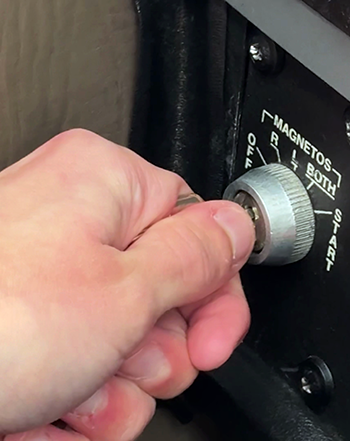Subscriber question:
"What’s an in-flight mag check and why would anyone do it?"
Martin:
 “We all learned to check the mags during the run-up before flight. Magnetos, ignition harnesses and spark plugs degrade over time, and this wear and tear can and will over time lead to ignition problems. When these problems have gotten severe enough, the mag check will fail, and we will taxi back to parking to have a mechanic figure out what’s wrong. Needless to say, the flight is canceled.
“We all learned to check the mags during the run-up before flight. Magnetos, ignition harnesses and spark plugs degrade over time, and this wear and tear can and will over time lead to ignition problems. When these problems have gotten severe enough, the mag check will fail, and we will taxi back to parking to have a mechanic figure out what’s wrong. Needless to say, the flight is canceled.
Some pilots like to do an additional mag check in flight, typically at the end of the cruise segment before starting a descent. Why would one do that? Well, the idea is to detect a developing degradation of the ignition system before it starts to impact performance or the safety of flight, so that repairs can be made at a convenient time – as opposed to canceling a planned flight when the ground run-up is the first time we see any signs of concern.
So how does an in-flight mag-check provide that early indication? Do the mags work any harder in flight than on the ground? No, they don’t. What is different, though, is that a stronger spark is needed in order to ignite the fuel/air mixture at normal cruise power settings than at the very rich and barely-above-idle power setting we normally use for the mag check on the ground. That’s especially true when running lean of peak EGT. Meaning that a gradual decline of the spark will be noticeable in-flight at cruise power long before it shows any abnormal signs during a ground mag check at 1,700 RPM.
So, with that knowledge, we can perform an occasional mag check in cruise. A little roughness is normal when switching to just one magneto, but a very rough running engine or a complete EGT drop-out on one cylinder is a sign that it’s time for maintenance at the next convenient opportunity. Take note of which cylinder had the EGT drop-out, and whether it happened with the ignition in the RIGHT or LEFT position. This information will tell your mechanic exactly which spark plug had the issue, and it will greatly reduce the time needed to troubleshoot on the ground.
One final piece of advice: Should you experience a complete loss of power on one magneto, resist the strong temptation to immediately turn the ignition back to BOTH. Instead, pull the throttle back to idle. Then wait a second before bringing the good mag back online.
Why prolong the dreaded power loss, you ask? To save your exhaust system. When a cylinder isn’t making any power, fuel and air are nonetheless going through it. There’s just not a strong enough (or any) spark to ignite combustion. So the unburned fuel and air mixture goes into the exhaust system, where it remains combustible. If you turned the mag back on at full power, you could introduce enough heat into the exhaust to ignite the unburned air and fuel mixture waiting there, which would result in a scary bang in the best case, and damage of your exhaust in the worst case. Bringing the power back to idle mitigates against that.”
To see details for performing an in-flight ignition check, see these pages from “Airplane Engines: A Pilot-Friendly Manual.”
Have you ever performed an inflight mag check? Would you?

